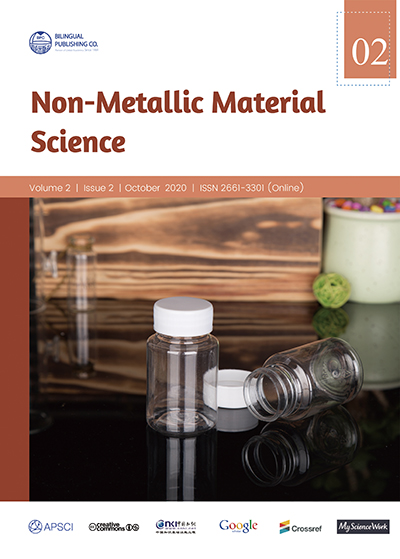-
236
-
220
-
218
-
218
-
123
Development of Superhydrophobic Polyester (Polyethylene terephthalate) Fabric for Multiple Applications
DOI:
https://doi.org/10.30564/omms.v2i2.1862Abstract
This study intended to develop a healthy and environmentally friendly super-hydrophobic PET polyester textile fabric using a specific Fluoro Silane finish (SHF). A novel SHF was prepared and applied on a polyester fabric using a pad-dry-cure method. The finished fabric was evaluated for the degree of hydrophobicity, durability and stain repellence. The finished fabric exhibited static water contact angle greater than 170o and received 90 AATCC (4 ISO) rating that is recognized as super-hydrophobicity and this property was maintained even after a 50,000-cycle abrasion test. FTIR analysis identified the characteristic peaks related to Si-O-Si and C-F asymmetric stretching bands of the finish on the fabric indicating a robust attachment on the fabric. Finished fabric did not show any change in appearance or tactile characteristics of the fabric.
Keywords:
Polyester fabric; Contact Angle; Fluoro silane; Super hydrophobic; Stain repellantReferences
[1] Zhao H., Ras H.A. Definitions for Hydrophilicity, Hydrophobicity, and Superhydrophobicity: Getting the Basics Right. The Journal of Physical Chemistry Letters, 2014: 686-688.
[2] Barthlott W., Neinhuis C. Purity of the sacred lotus, or escape from contamination in biological surfaces. Planta, 1997: 1-8.
[3] Kawai A., Nagata H. Wetting Behavior of Liquid on Geometrical Rough formed by Photolithography, DOI: https://doi.org/10.30564/omms.v2i2.1862 7 Non-Metallic Material Science | Volume 02 | Issue 02 | October 2020 Distributed under creative commons license 4.0 Journal of Applied Physics, 1994.
[4] Zhang X., Zhang J., Ren Z., Li X., Zhang X., Difu Z., Wang T., Tian T.,Yang B. Modulating two-dimensional non-close-packed colloidal crystal arrays by deformable soft lithography. Langmuir, 2009.
[5] Chen J. K, Qui J. Q., Fan S. K., Kuo S. W., Ko F. H., Chih- Wei C., Chang F. C. Using Colloid Lithography to fabricate silicon nanopillar arrays on silicon substrates. Journal of Colloid and Interface Science, 2012.
[6] Polizos G., Tuncer E., Qiu X., Aytug T., Michelle Kidder K., Messman J. M, Sauers I. From Hydrophobic to Superhydrophobic and Super hydrophilic Siloxanes by Thermal Treatment. Langmuir, 2011.
[7] Bao X.M., Cui J.F., Sun H.X., Liang W.D. Zhu Z.Q., An J., Yang B.P., La P.Q., Li A. Facile preparation of super-hydrophobic surfaces based on metal oxide nanoparticles. Applied Surface Science, 2014: 473- 480.
[8] Sahoo B.N., Kandasubramanian B. Recent progress in fabrication and characterization of hierarchical biomimetic super-hydrophobic, Royal Society of Chemistry Advances, 2014.
[9] Hoofnagle’s H.F.,Wu D.,With G.D., Ming W. Biomimetic Superhydrophobic and Highly Oleophobic Cotton Textiles, Langmuir, 2007.
[10] Ivanova N.A., Lavretsky A.K., Ivanova N.A., Zaretskaya A.K. Imparting Waterproof Properties to Cotton Surface. Protection of Metals and Physical Chemistry of Surfaces, 2011: 369-371.
[11] Xu C.H., Jia S.T., Zhang J., Tian L.Q. Super-hydrophobic surfaces on cotton textiles by complex coating of silica nanoparticles and hydrophobization, Thin Solid Films, 2009.
[12] Das I., De G. Zirconium based super-hydrophobic coatings on cotton fabrics exhibiting excellent durability for versatile use, Scientific Reports, 2015: 1-11.
[13] Meng S., Ye Y., Mansouri J.,Chen V. Crystallization behavior of salts during membrane distillation with hydrophobic and super-hydrophobic capillary membranes. Journal of Membrane Science, 2015: 165- 176.
[14] Bendak, S. M., & Marsafi, E. Effects of chemical modifications on polyester fibers. Journal of Islamic Academy of Sciences, 1991, 4(4): 275-284.
[15] Rı́ o, O. I., Kwok, D.Y., Wu, J. R., Alvarez, J. M., Neumann, A.W. Contact angle measurements by axisymmetric drop shape analysis and an automated polynomial fit program. Colloids and Surfaces A: Physicochemical and Engineering Aspects, 1998, 143(2-3): 197-210.
[16] Brassard, J. D, Sarkar D. K., Perron, J. Fluorine based superhydrophobic coatings. Applied Sciences, 2012, 2(2): 453-464.




 Subhas Ghosh
Subhas Ghosh





